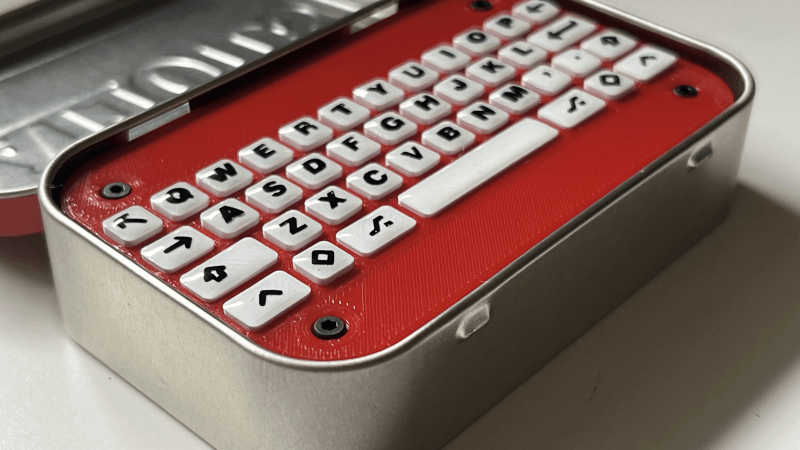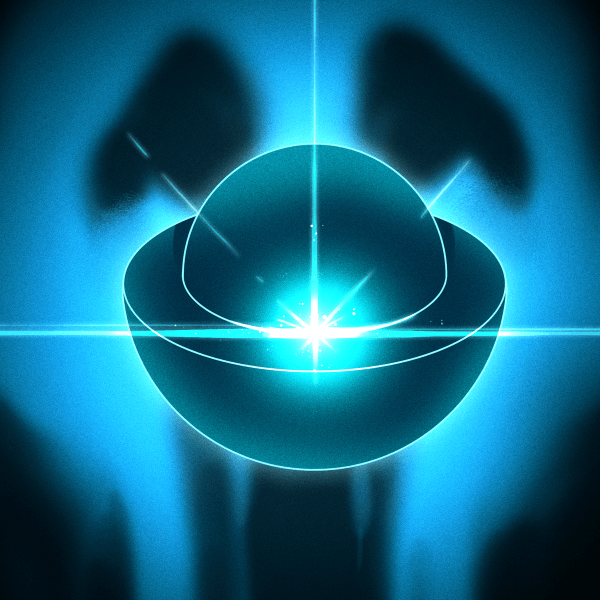Well, here’s a fresh idea! [flurpyflurples] is back from hiatus with the Mintboard, a 40% that fits inside of an Altoids tin. Who could ask for more than a rugged little Bluetooth keyboard with a built-in cover that fits in your pocket?
This build started with meticulously measuring the tin to figure out what kind of switches could be used. At first, this was going to be a 60% keyboard, but after a lot of design decisions and switch comparisons, [flurpyflurples] settled on a certain micro switch spaced at 7.3mm for a 40% layout. Then it was time to design a PCB.
 Although [flurpyflurples] tends to use Arduino Pro Micros in their builds, they went with the Nice! Nano this time for the Bluetooth capabilities. This means that they had to program it with ZMK instead of QMK, but found that QMK knowledge transfers rather nicely.
Although [flurpyflurples] tends to use Arduino Pro Micros in their builds, they went with the Nice! Nano this time for the Bluetooth capabilities. This means that they had to program it with ZMK instead of QMK, but found that QMK knowledge transfers rather nicely.
Let’s talk about those lovely legends. The keycaps are 3D printed of course, and the legends were cut out on a Cricut machine. The best part is that sealant — [flurpyflurples] used a few drops of UV nail polish top coat and cured it with light.
We think this looks and sounds fantastic, and would really like to know how to get such clean cutouts. According to [flurpyflurples] and the end of the build/demo video you’ll find below the break, the action is a lot like a Blackberry keyboard.

















Personaly,I have no affinity for keyboards,
though I do get a great deal of vicarious pleasure
from looking in at keyboard aficianados and all
of the dedication displayed designing,building,taking about,collecting,etc.
Gives me a sense that much that is wrong in the
world is in some way countered.
This is so friggin cool.
I am curious about whether the metal tin interferes with the Bluetooth signal. I also wonder if there would be any way to add number row, so many passwords require special characters and numbers these days (totally understand the is no room for the right-side keypad). Also wonder about the option of a magnetic reed switch so it just turns on when opened, vs the fragility of an external switch, but just random thoughts- I’m not criticizing, I couldn’t have done this and it is an awesome project.
Good questions, although i think i can help with the password question, as i use a 30% keyboard. There is a trick called Layers, where you press or hold one key and then the next keys type something different. For example, the Shift key is one you use all the time, which changes the lowercase letter keys to uppercase and the number keys to symbols. So for example, the diamond key shown may access a layer for numbers and symbols, while the key next to it may access the function keys. This is all easily programmable with ZMK or QMK.
In ancient times, many typewriters had both a “shift” key and a “figs” key, and each typebar had three characters on it, corresponding to the lower-case and upper-case letters, and other symbols. Same principle.
I would love to read more and try it. But just a reddit and a youtube. no instructions or ideas how to replicate. Why?
Because that takes time that most people don’t have and they owe you nothing?
People see this kind of gadget and the first thing they want to see is a way to actually build it. I’m watching the video at the moment and unless I knew how to do before hand it would be impossible. At the minimum post a place where you can sell me one.
Seriously… you expect a lot of work from people who owe you nothing. Be grateful you got to see it at all and get to use it as inspiration.
There is little use for hackaday to show irreproducible hacks, or hacks that have no documentation. Anyone can do anything they want, hackaday used to have better standards.
I sorta agree, but some people only need to see a new concept, and then explore a way to implement it.
If you cant figure out how to make something similar from the video and pics then you are on the wrong site! There’s absolutely nothing “irreproducible” about this project. Sure it’d be nice if the op provided design files, but don’t act like you are entitled to any of his work for free.
Indeed. Keyboards are well-explored territory, so not every article about a DIY keyboard has to describe how to lay out a PCB or install and customize QMK or its variants on a microcontroller. What it DOES need to do is describe the unique details, like the custom-made keycaps that look really nice. Clear UV-cure nail polish. Cool, that’s all I needed. Thanks! Other people may want step-by-step instructions, but that’s what Instructables is for.
Rant On: When an Altoids build will not have a title containing “fresh”, “air”, “mint”, “breath”? Rant Off.
May I say that this keyboard looks delicious?
Still, besides the danger of confusing the keys for breathmints, I’m already mixing the lower keys on my phone with the space under them. If I got one in Altoids case I’ll need also a microscope and a waldo.
P.S. Using two of these can you build a accordion?
Those keycaps have the look that Apple was trying to achieve in the early iPhone user interface!
Huh… how many full size keys can you fit in one of those little tins?
Probably at least WASD.
Well that would be cool in it’s way, I’m not much of a gamer though.
At least it’s not a chiclet keyboard.
You’ll see yourself out?
I think I might make one out of spite.
You might want to look into a membrane switch keyboard. Well done job, good name Altoids Mint; I wish you best of luck for the future.
The only thing missing is an equally tiny screen mounted on the underside of the lid
It’s a well-executed project, but it is soooo tiny !
While this look like a cool thing, it seems also nearly useless without digit keys.
And the on/off switch…just…why ? Who want to use a keyboard with a power switch ?
I’ll stick with my 1988 IBM/M…
Since it’s a Bluetooth keyboard, the switch makes sense. All other Bluetooth keyboards that I’ve seen have one, too.
Certainly not meant to replace the damn nearly immortal model M, but you can’t fit a model M in your pocket for use with your phone… Though you could loose your phone into the model M…
And yeah any wireless keyboard really aught to have a power switch to be sure to stretch the battery as far as possible. Though I think I’d skip it in this case as the tin should prevent accidental button press in your pocket, so just have the micro go to sleep after inactivity aught to be good enough power saving.
Sorry I wasn’t clear enough about that power switch but I was thinking of a sensor-like switch like the ones you find inside printers for instance – or even a reed switch – activated by the case opening/closing.
That said I generaly don’t access the net with a mobile device – even after installing a firewall & desinstalling the social network crapwares.
With that much 3D printing, I really don´t see any point with the Altoids can, except the heritage of building into them.
The bluetooth would work better without the shielding of the can, and it would be a nicer typing experience not having it down in the can.
And then he could have gone with the bigger switches and bigger keycaps too…
OTOH, I can buy small cheap keyboard with bluetooth in a nice package, but that´s not the point….
Constraints are often a source of creativity, forcing us to consider solutions we wouldn’t have otherwise. Never mind that the Altoids ton is a running gag in the community, or that it’s stronger for its size than plastic would be, or that half the point of being a Maker is artistic rather than practical; without the challenge of making it this (exact) form factor it might not have been built at all. And it is a pretty piece of work, which is all the justification it really needs.
I agree that the key legends may actually the single most impressive part of this build; surprisingly sharp, very accurately placed. Pretty. I don’t especially want to invest in a stencil cutter, but this is one of the more impressive applications thereof that I’ve seen.
Numbers and punctuation: The phone keyboard I’m using embeds those into the same space using shift or long-press access. While as noted the key legends are already pushing the limits, it might be possible to add to them (another layer in another color?) , or use a non-prompted mapping.
Re cover as automatic power switch: another solution would be one more key switch, NC, with a kicker inside the cover which depresses that switch when closed.
I’ve used ordinary nail polish for everything from a field-expedient replacement for Glyptol to adding tactile feedback (two drops will “fix” keyboards that are missing home-position cues) to tamper evidence. Wasn’t aware it now had a UV curing version, though I knew about the adhesives and the dental filler; that’s presumably more durable and I should investigate.
“or that it’s stronger for its size”
or that it’s curiously stronger for its size
FTFY B^)
Don’t underestimate the durability added by the metal tin, no worries about tossing that in a pocket or bag with my multitools, keys, etc. And then when the tin does get beat up you can just get a great excuse to eat a tin of mints and replace the outer shell.
If you had chosen to use an Elite-C, you could easily surface mount it with the castellated pins.
This keyboard brings back memories of the Grandmax KB-BT1L-BK Portable Wireless Mini Keyboard with Bluetooth Technology. This is a full function LED backlit bluetooth keyboard with Esc, Tab, Fn, Ctrl, Atl keys as well as a number row and keys to control audio/video playback. At 4.25″ x 2.25″ x 0.37″ it was slightly wider than an Altoids tin but it could be easily carried in a pocket or some thicker phone pouches along with your phone. Charging is via an included USB Mini plug. Works with iPad, iPhone4, Android 3.0, Symbian, Windows (XP, Vista, 7), Mac OSX, Linux, Playstation, smart pads, etc. Even came with a Driver Disc (cut down to the same height as the keyboard) with drivers for Symbian (Nokia) and Windows Mobile. I pulled it off the shelf and tested it on Chromebook, Windows, Android 14 and it worked on all with no issues. Even Windows without needing the Driver Disc. It’s a pretty cool little keyboard. I tried to find it to see if you could still purchase one but every place that had it on their website listed it as being out of stock/sold out. But, there is a company on Amazon called Rii that sells the exact same keyboard (upgraded with a USB-C connection) and Bluetooth 5.0 for $24.99. I’m tempted to get this if only for the USB-C upgrade, but, on the other hand, mine still works.
Don’t listen to him, Kristina!
You could mount the switches closer together vertically by alternating them between 0 degree and 90 degree rotations, and then staggering the rows to checkerboard the rotations. You then just have one set of contacts between every switch (instead of two sets).
I wonder how many tins of Altoids have just been dumped in the trash, because someone just wanted the tin…